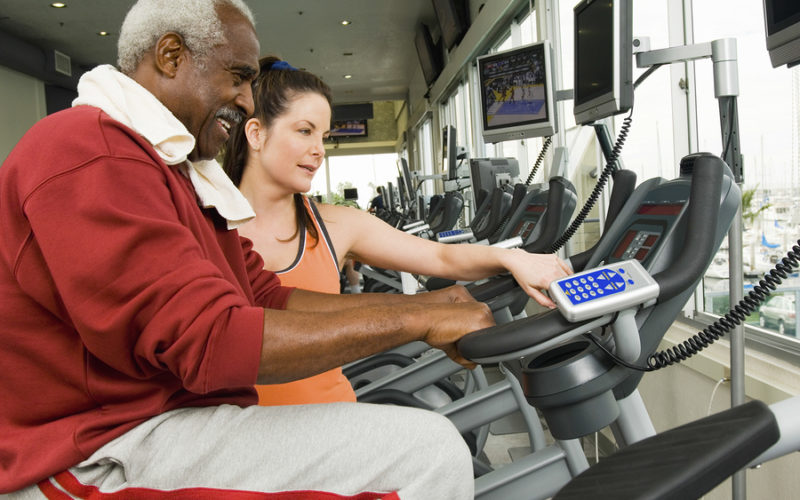By Chris Woolston, M.S.
You may not care about increasing your strength. “Firm, sexy abs” may be the last thing on your mind. Fine. But even if you don’t know your biceps from your bicuspids, there’s one muscle you should never ignore: your heart.
Other muscles just get small and flabby when they aren’t used. Your heart, on the other hand, might stop working. According to the American Heart Association, physical inactivity is a major risk factor for developing heart disease. The good news is that even moderate exercise, such as brisk walking, can make a big difference if done regularly. One study of healthy people over age 65 showed that those who exercised four to five times a week during their lifetimes had about 54 percent of the heart benefits seen in “master” athletes.
Exercise is also important if you have a chronic illness, such as diabetes, that’s often accompanied by heart trouble. People with diabetes are two to four times more likely to develop cardiovascular disease, according to the American Heart Association. If you want to avoid heart disease — or you’re recovering from heart trouble — a little sweat can work wonders.
I’ve been a couch potato all my life — isn’t it too late to start exercising?
No, that’s just one more reason to get moving. Even if you’ve already had a heart attack, a little exercise could save your life. A study published in the medical journal Circulation found that heart attack survivors who increased their activity levels were 90 percent more likely than inactive patients to be alive seven years after the attack!
How does exercise protect the heart?
Like any other muscle, the heart gets stronger with exercise. If you work out regularly, your heart muscle will grow a little larger and stronger, allowing it to move more blood with each beat. As a result, it takes fewer beats to get you through the day. Your heart rate drops, and your heart will enjoy a well-deserved rest.
Even more important, exercise helps protect your arteries — where heart attacks get their start. Regular exercise removes LDL (“bad”) cholesterol from your blood. If you have too much of this fatty substance, it starts sticking to the walls of your arteries, causing arteriosclerosis, or hardening of the arteries. If the arteries feeding the heart become clogged — a condition called coronary heart disease — a heart attack may be just around the corner. The protection doesn’t stop there. Exercise also increases your level of HDL (“good”) cholesterol, a substance that helps keep your arteries clear.
In fact, your goal should be to make regular exercise a permanent part of your life. Besides being good for your heart, exercise has numerous other benefits, such as reducing stress, building strength and endurance, and helping prevent osteoporosis, or bone thinning. Regular workouts can also lower high blood pressure and prevent Type 2 diabetes, a condition that greatly raises the risk of heart trouble.
What kind of exercise is best?
You don’t have to live at the gym to protect your heart. The American Heart Association (AHA) updated its guidelines on exercise in 2007, and now recommends at least 30 minutes of moderate exercise (like brisk walking) five days a week, or 25 minutes of vigorous exercise on at least three days a week. In addition, the AHA recommends that adults lift weights or doing other muscular strength and endurance exercises at least twice a week. (If you need to lower your blood pressure or cholesterol, up that work out to 40 minutes at least 3 or 4 times a week.)
After getting the go-ahead from your doctor, exercise to the point that you break a sweat or feel yourself short of breath. Start with as little as 5 minutes of exercise, which just about anyone can do, and build it into your daily routine. For example, you might start by taking a 5-minute daily walk at lunchtime, or walking up and down a staircase for 5 minutes at a time. Try increasing the amount you exercise by a few minutes each week until you reach your target; realistic goals make it easier to succeed. The reward: Unlike the stock market, exercise will give back everything you invest in it, with some benefits that are almost immediate.
Vigorous exercise — aerobic dancing, cycling, uphill hiking, swimming, and jumping rope — will definitely condition the heart and lungs; stop-and-go activities like basketball, tennis, and soccer can help condition them as well. Interestingly, aerobic activities that involve the upper arms seem to offer more protection than other types. If you don’t like rowing, swimming, or team sports, your best bet for heart protection is probably brisk walking. You can start anytime, and best of all, it’s completely free.
But remember, any activity is better than nothing. You can give your heart a boost simply by working in the garden, getting up to change the channel instead of using the remote, doing chores around the house, and taking the stairs instead of the elevator. Do you know people who drive two blocks to mail a letter or buy a carton of milk? Don’t be one of them — put away your car keys during the day and do your errands on foot whenever possible.
If I’m a construction worker, do I still need to exercise?
Yes. It’s a common myth that people who have non-sedentary jobs get enough exercise. They may do a lot of walking around, but it is usually not sustained. You need at least 15 to 20 minutes of uninterrupted exercise to get the metabolic benefits.
Is it safe for me to exercise?
If you’re overweight or have been sedentary for a while, you’ll want to get back into exercising gradually. In addition, you should have a thorough checkup before starting an exercise program.
Ask your doctor what heart rates you should target while exercising, especially if you’re over 50, are pregnant, or have a condition that might make it difficult for you to exercise. Once you get the go-ahead, start slowly. Drink lots of water, including a glass before and after exercising, and keep a water bottle with you at all times; keeping the body supplied with plenty of water helps prevent heat exhaustion and dehydration. See a doctor immediately if you feel light-headed, disoriented, faint, or experience chest pain, dizziness, and nausea.
Also, avoid being a “weekend warrior.” If you’re sedentary all week — that is, staring at a monitor or being a couch potato — don’t go full blast on the weekends to make up. Not only is it a good way to get injured, but older, infrequent exercisers who work out too vigorously may even risk a heart attack, according to a 2007 report in the journal Circulation. Any exercise is better than none, but sedentary types should exercise moderately and check with their doctor before starting a work-out regime.
Not every heart, in fact, can handle all the rigors of exercise. If you have heart disease, you should have a thorough checkup before starting an exercise program, even if you just want to walk around the block. If you have heart pains or experience shortness of breath after a walk up the stairs, your doctor may want to give you a stress test, an exam that monitors your heart while you walk on a treadmill or ride a stationary bicycle.
The good news is that most people with heart disease can continue to lead an active life. As soon as you get your doctor’s okay, you can start reaping the benefits of exercise. You’ll feel stronger, more energetic, and less stressed. And one muscle will be especially grateful.
References
Ades, P.A. and Coello, C.E. Effects of exercise and cardiac rehabilitation on cardiovascular outcomes. Medical Clinics of North America 84(1):251-264.
Leon, A.S. Exercise following myocardial infarction. Sports Medicine 29(5): 301-311.
Franklin, B.A. and Sanders, W. Reducing the risk of heart disease and stroke. Physician and sports medicine.
Frank B. Hu, M.D.; Meir J. Stampfer, M.D., Caren Solomon, M.D.; Simin Liu, MD; Graham A. Colditz, MD; Frank E. Speizer, MD; Walter C. Willett, M.D.; and JoAnn E. Manson, M.D. Physical Activity and Risk for Cardiovascular Events in Diabetic Women, Annals of Internal Medicine, Vol. 134, No. 2, 96-105
JoAnn E. Manson, Frank B. Hu, Janet W. Rich-Edwards, Graham A. Colditz, Meir J. Stampfer, Walter C. Willett, Frank E Speizer, Charles H. Hennekens. A Prospective Study of Walking as Compared with Vigorous Exercise in the Prevention of Coronary Heart Disease in Women, New England Journal of Medicine Vol. 341, No. 9.
“Getting started on an exercise program,” American Heart Association.
Canadian Institutes of Health Research. INTERHEART: Nine factors that could save your life.
Smith SC et al. AHA/ACC Guidelines for Secondary Prevention for Patients With Coronary and Other Atherosclerotic Vascular Disease: 2006 Update. Circulation. 113:2363-2372. May 2006.
American Heart Association. Physical Activity.
Thompson PD et al. Exercise and Acute Cardiovascular Events: Placing the Risks in Perspective. Circulation. 115(17). May 1, 2007.
Haskell W et al. Physical Activity and Public Health: Updated Recommendations for Adults from the American College of Sports Medicine and the American Heart Association. August 2007.
American Heart Association. Diabetes and cardiovascular disease.
Lifelong Exercise Keeps Seniors Young at Heart.





















